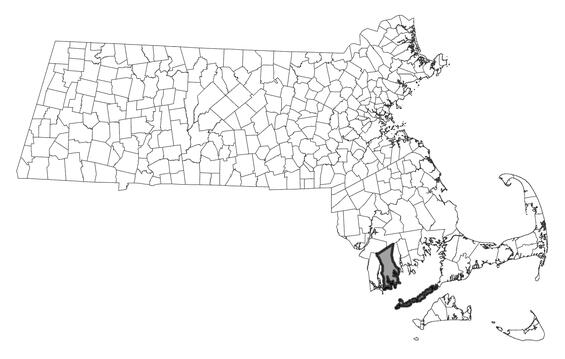- Scientific name: Myriophyllum pinnatum
- Species of Greatest Conservation Need (MA State Wildlife Action Plan)
- Special Concern (MA Endangered Species Act)
Description
Pinnate water-milfoil (Myriophyllum pinnatum) is an aquatic perennial herb of the Haloragraceae family. The plant grows either submersed in water or along exposed muddy shores. When submerged in water, the elongate stems bear weak, finely dissected leaves that can be alternately arranged, whorled, or scattered. The tips of the plants emerge out of the water, where whorls of smaller, less finely divided, bract-like leaves dwarf the tiny, inconspicuous flowers borne in their axils. The terrestrial form of the plant is freely-branched, with stiffer leaves than those of the submersed form. The stems of pinnate water-milfoil can grow up to a meter (a yard) long.
Distinguishing the various species of water-milfoils is difficult, especially in the vegetative condition, and a technical manual and an expert should always be consulted. A combination of characters must be used to distinguish the pinnate water-milfoil: 1) the presence of whorled, alternate, and scattered leaves on the submersed stems (rather than regularly whorled or alternate); 2) the presence of longitudinal ridges on the fruit (rather than smooth); 3) the presence of flowers and fruits in the axils of emersed, terminal, bract-like leaves (rather than submerged leaves). Other helpful characteristics include the absence of winter buds, called turions, and the presence of bract-like leaves that are very much longer than the flowers.
Common water-milfoils could easily be confused with the pinnate water-milfoil. For example, the widespread, non-native variable-leaved water-milfoil (M. heterophyllum) could be confused with this species. However, variable-leaved water-milfoil has regularly whorled leaves. The lowly water-milfoil (M. humile), a native species, has regularly alternate leaves and smooth fruit without ridges borne in the axils of submersed leaves.
Life cycle and behavior
Pinnate water-milfoil is not recognizable until July. It starts to produce flowers and fruit on an emersed stem or if stranded on mud, an upright stem. Recognizable vegetation should be present from the beginning of July through mid-September. Flowers and fruit are present during that period. Leaves above and below water look very different. It is wind-pollinated.
Population status
The pinnate water-milfoil is listed as a species of Special Concern by the Natural Heritage and Endangered Species Program because it is a rare plant limited by an uncommon habitat type. It has been verified in three populations since 1999 in Bristol and Dukes counties. There are twelve historic stations in Massachusetts. As with all species listed in Massachusetts, individuals of the species are protected from take (picking, collecting, killing) or sale under the Massachusetts Endangered Species Act.

Distribution in Massachusetts. 1999-2024. Based on records in the Natural Heritage Database.
Distribution and abundance
The pinnate water-milfoil occurs from Massachusetts south to Florida and west to North Dakota and New Mexico. Many states have not assessed it, however, all that have completed an assessment of the species in the state have found it to be critically imperiled (10 states), imperiled (3 states), vulnerable (2 states) or possibly extirpated (1 state). In New England, it is not found in Maine, New Hampshire or Vermont. It is considered critically imperiled in Connecticut and Rhode Island and imperiled in Massachusetts.
Habitat
In Massachusetts, the pinnate water-milfoil inhabits coastal salt pond communities. It is usually in ponds without inlets or outlets and with sandy to muddy bottoms. It is also found on the peaty exposed shores of these ponds, in boggy pond holes, and filling the center of deep clay holes. It is most commonly associated with common reed (Phragmites australis), water-purslane (Ludwigia palustris), and saltmarsh fleabane (Pluchea odorata).
Healthy habitats are vital for supporting native wildlife and plants. Explore habitats and learn about conservation and restoration in Massachusetts.
Threats
The greatest threat to the pinnate water-milfoil is alteration of its coastal salt pond habitat. One such alteration is the establishment of the invasive common reed (Phragmites australis) in salt ponds. Common reed can completely fill small salt ponds, lowering standing water levels and crowding out other vegetation. Nutrient inputs from surrounding residential developments or cattle grazing can also upset the normal chemical balance of the pond, which may lead to changes in species composition. Filling or dredging of coastal salt ponds for residential development is also a threat to pinnate water-milfoil. Sea level rise is likely to overtake and destroy these salt ponds, which currently are a mix of fresh and salt water (Staudinger et al. 2024). This species does not tolerate high saline levels.
Conservation
Survey and monitoring
Surveys for pinnate water-milfoil need to pay special attention to the habitat and if there are any potential threats to it. Surveys are best done when the species may be in flower or fruit from July through late September.
Management
The exact needs for management of the pinnate water-milfoil are not precisely known. However, controlling populations of common reed in salt ponds where pinnate water-milfoil grows will benefit this rare plant by reducing competition for space and resources. In addition, allowing large, vegetated buffer zones to persist around salt pond habitat can protect the pond system from nutrient-laden runoff.
Research needs
Research is needed to determine whether this plant can be grown in a nursery or garden setting for purposes of reintroductions. Questions about seed germination and seed storage over winter will need to be answered. As sea-level rise may create new habitat while at the same time isolating current populations, this strategy for reintroductions could prove useful to long-term conservation of this species.
Contact
| Date published: | May 9, 2025 |
|---|